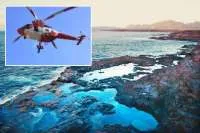The Canary Islands are facing dangerous UV radiation levels of ‘extreme risk’
- 16-07-2024
- National
- Canarian Weekly
- Photo Credit: Futurismo Canarias
The Canary Islands, despite their subtropical geographic location, experience UV radiation levels comparable to tropical regions. Eduardo García-Ramos, a Public Health Directorate technician and coordinator of the UV Radiation Preventive Action Plan, highlights that the archipelago often registers the highest levels on the 0 to 11+ UV index scale.
The UV radiation levels in Gran Canaria reached 12 on Sunday and Monday, as reported by the Spanish Meteorological Agency (AEMET). The rest of the archipelago recorded a UV index of 11.
Forecasts predict that these extreme levels will persist until Thursday, placing all islands at "extreme risk." Such high levels of UV radiation can cause severe health issues, from DNA damage and sunburn to eye conditions like cataracts and skin cancer.
"UV radiation is increasingly penetrating the Earth's surface," warns García-Ramos. According to the World Health Organization (WHO), climate change exacerbates this issue by affecting the ozone layer, which partially absorbs UV radiation.
García-Ramos stresses the importance of protection year-round, not just in summer, as UV levels can reach 10 and 11 even in winter, posing "extreme" to "very high" risk. Many people work outdoors, not just beachgoers, and need to take precautions.
AEMET confirms that the Canary Islands receive the highest UV radiation levels in Spain throughout the year. Comparatively, the current year’s UV levels in the islands surpass those of 2023.
Health Recommendations for High UV Radiation
The Health authorities provide cumulative recommendations based on UV index levels.
- For moderate risk (3 to 5), people should wear hats, use sunscreen with at least SPF 30, and cover up with long-sleeved clothing and sunglasses.
- High-risk levels advise against sun exposure for infants under one year.
- For very high risk (8 to 10), children under three should stay out of the sun, and outdoor activities should be avoided from 11:00am to 5:00pm.
- At extreme risk, as currently faced by the Canary Islands, the general advice is to avoid sun exposure altogether.
García-Ramos reveals that a new comprehensive plan addressing year-round UV risks is in the works, to be presented in September. Supported by dermatology and ophthalmology scientific societies, this initiative will extend to workplace safety protocols, integrating sunscreen into personal protective equipment (PPE) for certain jobs. It will also target schools and senior centres, ensuring outdoor activities are safe and appropriate sun protection measures are taken.
The WHO notes that UV radiation levels depend on factors like sun elevation, altitude, and cloud cover. While clearer skies increase UV levels, even cloudy days pose risks. Reflective surfaces like snow, sand, and water also amplify UV exposure.
Public awareness remains a challenge due to the long-term effects of UV damage. Immediate harm isn't always visible, making it essential to use sunscreen in all outdoor settings, from beaches to countryside walks. Skin cancer rates in the Canary Islands have surged by 40% between 2020 and 2024. "For adequate vitamin D activation, 15 minutes of daily sun exposure is sufficient," García-Ramos concludes.



























































